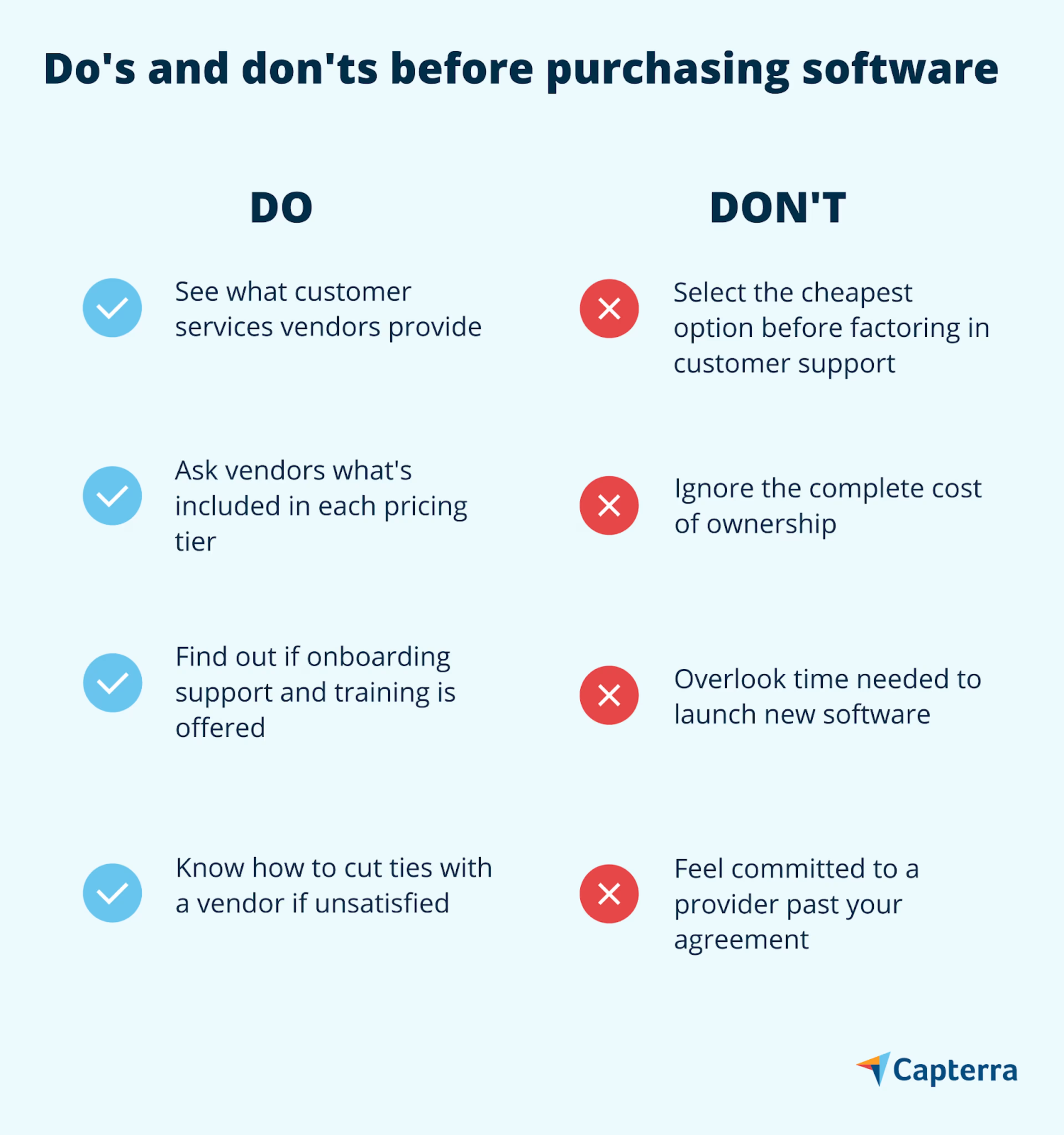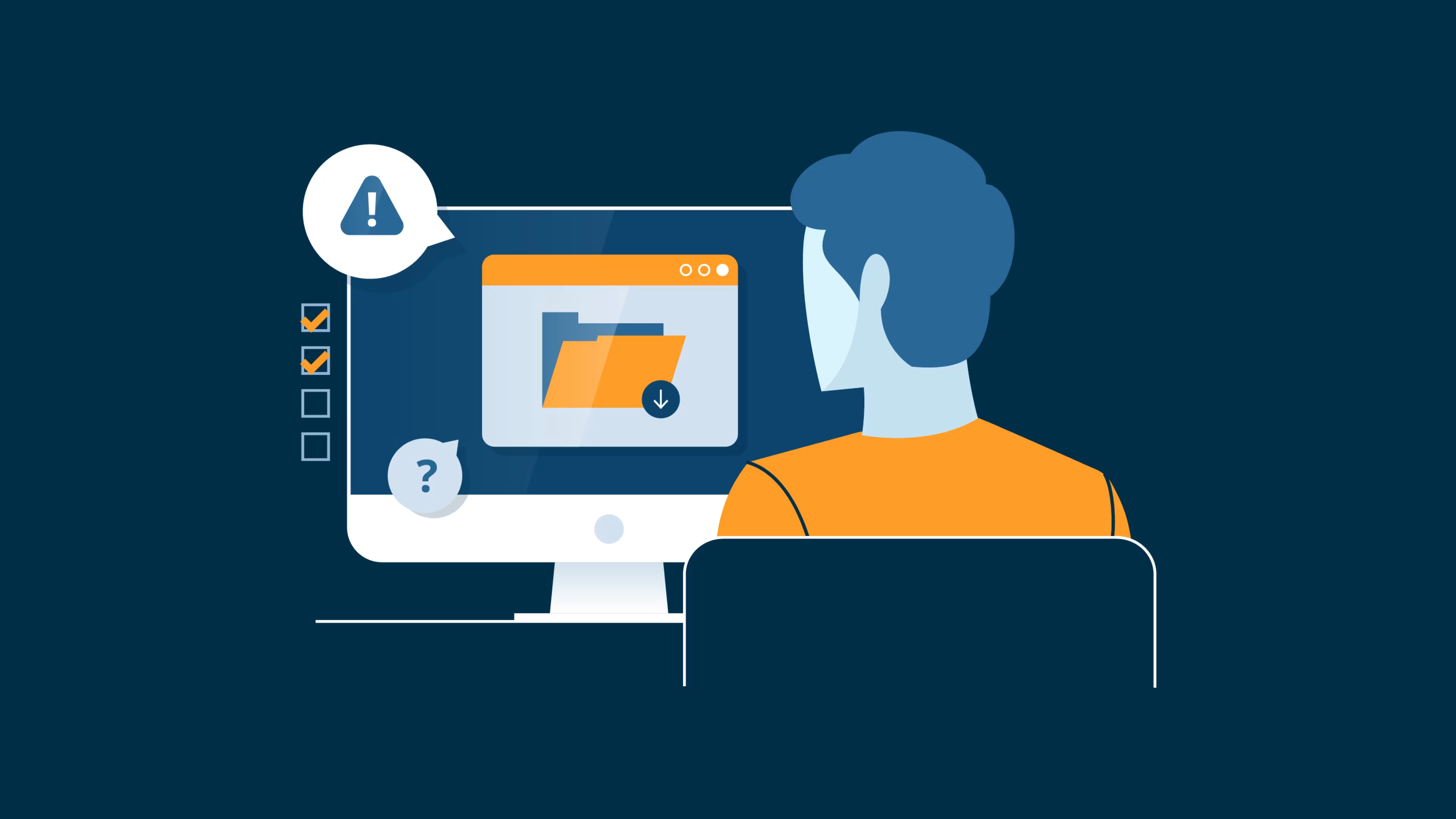Learn from those who have been through the software buying process—find out what they wish they had known, what they regret, and how you can avoid similar mistakes.
Purchasing software is a big decision, requiring money and time. If you’re leading the software buying process for your business and getting ready to make the final call, you may be worried you’re not making the right decision.
It can be hard to know everything you should consider before purchasing. Before we dive into details, consider this quick checklist of some essential do’s and don’ts to keep in mind as you read the article.

Now let’s dive a little bit deeper.
5 final considerations before purchasing software (from buyers who’ve been there)
We reached out to other experienced software buyers who’ve been in your shoes to see what they wish they knew before their purchase. Some explained their biggest regrets (and how to avoid them). Here’s what they said.
1. Consider the customer support level you'll need after purchase
Support can have a significant impact on whether the software is successful or unsuccessful for your company. This is particularly true if your IT staff is tiny, the software is complicated, or all employees use it…Take careful note of each software vendor's support hours before choosing one. The issue of support hours should cover not only the hours when you can receive support but also how to do it.
Tom Miller
Chief Marketing Officer of FitnessVolt.com[1]
Software vendors offer different types of customer service options, from conversations with real people to online self-service forums. Some vendors provide a full range of customer service options to all customers, while others incorporate varying levels of service in their pricing plans or as additional charges.
It's important to anticipate the level of customer support you'll need once you own the software.
Check with vendors before purchase and ask how they handle customer service to make sure they provide options you like and that fit your budget.
You can also learn how others have experienced customer service from a particular vendor by reading reviews on Capterra. Look for service ratings and comments that address the quality of service provided.
2. Find out the total cost of ownership before purchase
While it's important to consider the upfront cost of the software, it's also important to think about the long-term costs, including maintenance, updates, and training.
Dmytro Kondratiev
Legal Board Advisor at LLC Services[2]
Sure, you might know the base price to purchase your software, but do you know the cost of extensions, integrations, your service contract, and all the other add-ons that pop up during the software-buying process?
You need to determine the total cost of ownership. That includes how much the software costs to obtain, implement, and maintain.
Ask the vendor about their pricing tiers, what's included with each one, and what features or services (such as customer support or installation) are sold separately.
Many vendors offer discounts for those paying annually (instead of monthly) or for nonprofits, so ask about ways to reduce the price.
Accounting for the total cost of ownership, decide in advance the maximum price you're willing to spend on this software and if you're willing to adapt your budget to find the perfect fit.
3. Make sure the software price aligns with your business needs
I recently purchased software for my company because I want my employees to be more productive and efficient. However, I’m a bit tight with our budget due to inflation and other factors that require saving funds, so I chose software based on price alone, and now I regret it … Pricing is part of any business decision, but it shouldn’t be the only factor because basing your decision on price point alone may not ensure you’ll be getting the most value.
Zachary Colman
CEO of Creatitive[3]
Many economists are predicting a global recession to impact businesses in 2023[4]. Companies appear to be taking actions to reduce costs but skimping on software doesn’t appear to be one of them.
According to Capterra’s 2023 SMB Software Buying Trends Survey*, a majority of U.S. SMBs (57%) estimate they’ll spend anywhere from 10% to 20% more on software in 2023 compared to 2022. Only 4% estimate they’ll decrease their software budget in 2023.
One possible reason for this could be that businesses understand that investing in the right software is an investment in the business itself and will provide long-term value.
Budgets are necessary boundaries that help guide the buying process. It is important to not overspend on software, especially if the software has features that may seem “cool” but are ultimately unnecessary.
However, it is equally important to not underspend on software, meaning buying software simply because it is on budget even if it doesn’t have the key features your team needs. Remember: Buying the wrong software is worse than no software at all.
Before making the final decision and signing contracts, make sure the platform has all the key features and functionalities your business needs.
4. Budget extra time to set up your new software
Implementing new business software can be a complex process, and it is important to understand the steps involved and the resources that will be required. It may be helpful to work with a vendor or a consultant to ensure a smooth implementation process.
Yaroslav Ivanov
Chief Visionary Officer at Top of the World[5]
Whether the software you're getting is cloud-based or on-premise, you'll also need to budget time to get adjusted to a new system. Setting up new software is often more difficult than it appears.
In fact, the top reason SMBs decide against investing in new software is concerns about the implementation process, such as downtime and steep learning curves during the training period (45%)*.The best way to overcome this obstacle is to ask the vendor what installation, training, and onboarding support they provide.
If they charge extra for these services, factor that into the total cost of ownership.
If your organization has an IT department, make sure they're involved in installation and training discussions, as you'll likely need their expertise and support when setting up the new software. Conversely, if you’re spearheading the software buying process and you are the business’s IT department, make sure you include team members from the departments who will be using the software when developing the implementation plan.
Be sure to also budget time for your team to adapt to a new software. Even with great training, it takes time to adjust to new processes. Accept that there will be a learning curve and modify the team's short-term expectations accordingly.
5. Know when and how to cut ties with a vendor
We review all of the software products annually and cut the ones we don't need [every year]. 1) Make sure you backup the data of the product you are leaving. 2) Have the other product live and team onboarded to the new tool. 3) Fully cancel the product after making sure [of] no missing data or issues. This 3-step approach makes sure we have minimal interruption in the move.
Zach Klempf
Founder & CEO of Selly Automotive[6]
Some people have regrets after their first foray into the software -buying process. But don't lose hope if a certain software product ends up being more expensive than originally planned, too difficult to implement, or too confusing for your team to adopt efficiently.
Even if the software you chose didn't end up being the perfect fit, chances are it does most of what you need it to do. And now you have a better idea of what you need.
Remember that you can always switch software providers at the end of your agreement, and you'll walk away with more experience.
A stronger sense of your software needs and experience with the buying process will make it more likely you'll find a great option next time.
Learn from others who've been through the software buying process before
Ask others in your professional network about their experiences buying software. Whether colleagues at your own company, others in your industry, or friends in other lines of work, you can learn a lot from hearing stories about what worked well (or didn't) from other people.
You can also learn a lot from reading software reviews on Capterra's product pages. Capterra reviews feature the reviewer's job title, industry, and company size, as well as star ratings and in-depth commentary. Many of these reviews include ratings or commentary about the considerations covered here (customer service, costs, setup, and decision-making).
By finding reviews relevant to your job and industry, you can trust the reviewer's perspective and look for more targeted commentary that speaks to your considerations.
